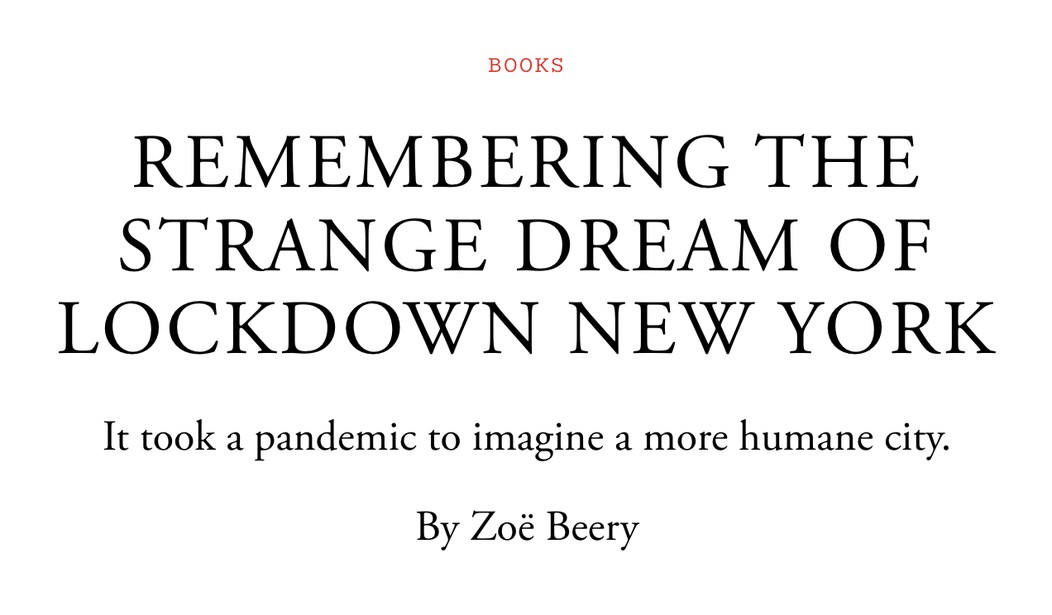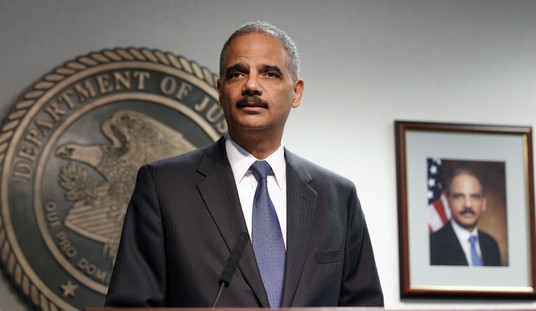There is something fundamentally sick about the Branch COVIDians.
This isn’t exactly news, but the evidence keeps piling up. The latest of which is a review of two books in The Atlantic that ran last month. The piece is one in the genre of reviews where the author both provides a review of books and riffs off a narrative that the books create, based upon the common elements of a social analysis embedded in the works.
In this case, the common element is a longing for the days when COVID dominated life within the city of New York.
New York City in the early days of pandemic shutdowns was a horrible place to be. As fatal chaos unfolded in the hospitals, a gloriously noisy soundscape was replaced by terrifyingly constant sirens and the thrum of refrigerated morgue trucks. Anyone on the sidewalk, many of them essential workers who had no choice but to be there, moved away from other passersby in a fearful overshoot of the recommended six-foot separation. A famously packed city became a fraught place where it felt like getting too close to anyone might send both of you to a mass grave.
Despite being painful, these things are simple to talk about. They are morally clear: Death is awful; fear is awful. What many New Yorkers admit more gingerly is that when the pure terror began to subside in late April 2020, we ventured out and discovered that some things about the city were better. No tourists, no crowds, wealthy New Yorkers–by-convenience gone to the Hamptons or upstate. Left behind was everyone who couldn’t afford to leave or didn’t want to. New York felt more neighborly, like a city half its size.
This is an interesting take and quite revealing about the psychology of a certain type of person. Typically odes to New York City are based upon the idea that the city is especially vital. You can walk the streets at any time of day or night and find a vitality that is rare. Every variant of humanity is represented and every entertainment whether high culture or low surrounds you. Examples of astounding human achievements are everywhere you look.
But no, COVID-dominated New York is better, and even the fraying of civilization embedded in the last two years was preferable to the New York that most people love.
This transformation was best experienced on a walk with a friend. What might previously have been a casual hangout felt not life-affirming but life-confirming, proof that COVID hadn’t killed either of you yet. Among the New Yorkers who picked up this walking habit during lockdown is Michael Kimmelman, the architecture critic of The New York Times. Six days after then-Governor Andrew Cuomo declared a state of emergency, Kimmelman invited a slew of friends and colleagues to give him tours of their neighborhoods, which he proceeded to write about in a series of columns for the paper. These offerings urged New Yorkers not to abandon one another or our city, to go outside with friends when we couldn’t be inside, and to peacefully visit usually miserable places such as Times Square and the Brooklyn Bridge.
Last month, he published The Intimate City: Walking New York, a collection of these essays. Many New Yorkers will appreciate the book for immortalizing a peculiar time when the coronavirus pandemic “opened a window through which to see New York, if only briefly, in a new light,” as Kimmelman writes in the introduction. He wanted to “capture a precarious, historic moment when New Yorkers found strength in their shared neighborhoods and one another.”
“Intimate City” embraces a wistfulness for the sense of purpose and focus that tragedies can bring. But unlike the community tragedies often inspire, COVID created a kind of division that created competing cliques. “Intimate City” is more the celebration of a a clique than of a community. It is for those who long for a city in which the people they dislike are driven out.
Two years on, this period of desperate togetherness feels like a strange dream as New Yorkers suffer through the long tail of what the writer and activist Naomi Klein calls the shock doctrine—when those in power take advantage of a crisis to impose austerity measures and privatization. The new mayor is hollowing out his own workforce and slashing public budgets despite projections of a surplus. Landlords are raising rents to record highs while keeping affordable apartments off the market. But for a few months, many New Yorkers experienced the opposite: widespread welfare, free COVID-related health care, a pause on most evictions, and proof that what many people would like to do is not work in an office but spend time with, take care of, and stand up for one another. Looking back at the spring of 2020 is a reminder that a more humane world is possible, but we got there only because of a pandemic, and only for a moment.
The clique, of course, is the far Left. When Mayor Adams is an exemplar of the far-Right intent on hollowing out the city and making it less humane, you know you are dealing with kooks. Combine this with a celebration of socialism that was created by mass devastation, you know you are dealing with a sick ideology.
Even the author of the book is far too normie for The Atlantic author Zoë Beery.
The book’s first chapter is the most striking, reconstructing New York’s topography and biosphere before the Dutch colonized Manhattan. It also makes an unforced error in featuring a tour guide who talks about the Lenape people in the past tense, when their descendants are very much alive, including in their New Jersey and Delaware homelands. Narrow perspectives plague much of the book: Nearly all of Kimmelman’s guides have fancy pedigrees, and he devotes 14 of the 20 tours to Manhattan (a chapter titled, simply, “Brooklyn” treats an anodyne slice of the area as a synecdoche for the city’s most populated borough). The Intimate City thus tells an incomplete story. The protests that dominated the summer after the killing of George Floyd are mentioned just once, and by López, not Kimmelman. Absent is an acknowledgment that the tourists weren’t the only people whom many New Yorkers were glad to see gone.
That’s why Zoë must turn to another book, to capture a New York rediscovering another great aspect of a New York City from a better era: it’s decline into chaos in the 1970s.
These particular missing pieces are the focus of Jeremiah Moss’s Feral City: On Finding Liberation in Lockdown New York, a memoir that establishes the first wave of the pandemic as a brief, magnificently unruly undoing of New York’s corporatization. It is animated by Moss’s grumpiness at seeing the city’s edges sanded down for decades, a phenomenon he has spent the past 15 years documenting on his blog, Vanishing New York. The book begins with a detailing of his “Before Times” misery at watching disengaged Millennials take over formerly rent-stabilized apartments in his East Village building. He calls them “New People”—not new to the city, but what he sees as a new type of person: “ideal neoliberal subjects … walking advertisements exerting influence.” (The writer Sarah Schulman describes an almost identical process in her 2012 book, The Gentrification of the Mind, of blithe 1990s yuppies overtaking queer neighborhoods ravaged by AIDS.) When these people begin fleeing the city in March of 2020, and in many cases later leave for good, Moss is elated in spite of the awful events that prompted their flight.
Of course. Perhaps this nostalgia for decay and social breakdown explains the systematic destruction of American culture that has only accelerated during the Joe Biden years. Decay and decline are a good in itself, as the privileged who falsely identify with the downtrodden can experience the thrill of slumming with the plebs. You see this false self-identification of the college educated radicals who claim solidarity with people of whom they have no real knowledge. The riots and destruction of the summer of 2020 were, to use the phrase of a Seattle’s Maror, “a Summer of Love.”
Moss writes of a New York returning to what he sees as its rightful entropy, energy “heaving up from under pavement” to reveal “a dirty, spontaneous city” where “anything can happen.” What ultimately happened was free fridges, outdoor dance parties, and, after Floyd’s murder, tens of thousands of people flooding the streets to demand justice for Black people killed by the police. Moss joins the protests, spending many hours in an Occupy-style encampment outside City Hall and in Washington Square Park, which during the shutdowns came alive with parties.
His enthusiastic dispatches from these scenes are transportive—a walking tour through recent history. Every chapter is full of tender portraits, especially of young people who found meaning or a home in these places. As a trans man who came to New York to feel safe in its embrace of the strange and subcultural, Moss is glad to see another generation of weirdos filling the city in the absence of his loathed neighbors. One raucous August night in Washington Square, he hears a break-dancer shout, over a fight by the fountain, “You wanted old-school New York, you got old-school New York!”
It is, frankly, disgusting. And emblematic of the radicals who embrace the streets, rather than Davos. While the Davos Elite long for a world where they control everything and everyone, there is another strain of radicalism that longs for anarchy and pure destruction.
These are the nihilists, who are too often used by the Elites, but who are as disdained by them as by us.
What is striking, of course, is not the existence of such people. Ideological movements are often coalitions, and conservatives have their own contradictions within the coalition that opposed the Left.
No, what is striking is how an Elite outlet like the Atlantic flirts with the nihilism, instead of being repelled by it.
This is symbolic of the fraying of the culture. The coalitions which have been competing for power over the past few decades used to share a common vision of an America in which people could thrive, despite their vast differences in how best to get there.
No longer. The Left has become committed to decline, and this, if anything, will undermine the project of the Elite. If even The Atlantic flirts with, without yet embracing, the anarchistic instincts of the radical Left elements of their coalition, perhaps a future where eating bugs instead of beef might yet be averted.
Or, perhaps, this is merely performative.








